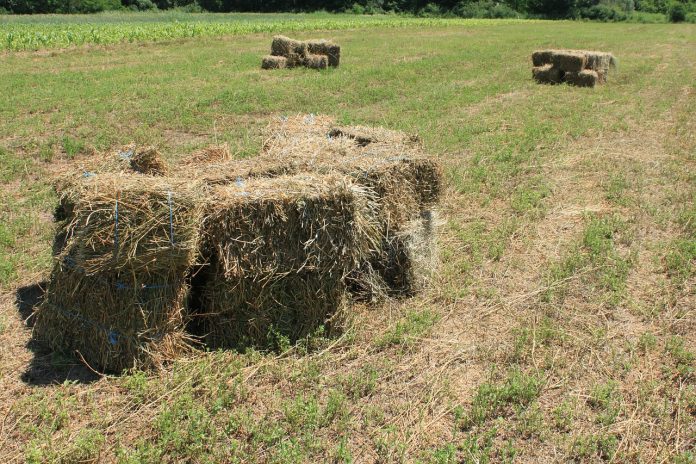It’s the time of year to be thinking about weeds in alfalfa.
This time of the year, metribuzin and Velpar can be applied to alfalfa to control certain weed species.
However, with the abnormally warm weather we just experienced, alfalfa has come out of dormancy.
Limited application
Since alfalfa has begun to grow, metribuzin can’t be applied to alfalfa this spring, unless you are in an area where plants have not begun to grow.
Velpar should be applied to dormant alfalfa, but can be applied to plants having up to two inches of growth.
Velpar will control dandelion, downy brome and most winter annual weeds such as common chickweed, purple deadnettle, and mustard species.
Apply Velpar at 3 quarts per acre rate to control dandelion.
With Velpar, no crop, other than corn, can be planted until two years after application, unless deep plowing has occurred — then corn can be planted 12 months after application.
Cressleaf
Cressleaf groundsel is becoming more prevalent in western Ohio and other parts of the state causing it to become a weed in alfalfa fields.
This is a big concern because cressleaf groundsel is poisonous to livestock even after the hay has been dried.
Cressleaf groundsel can be identified by its presence as a rosette having leaves with numerous rounded deep lobes with the tip of the leaf rounded as well.
The leaves may have a purple color to them. In the spring when the plants begin to produce a stem, the stems are hollow, ridged and usually purple.
The flowers have a yellow center and yellow petals similar to a sunflower head because it is an aster species. The flower is about three quarters of an inch to 1 inch in diameter.
There are numerous flowers on a single plant. Seeds are dispersed by wind for long distances like marestail.
Control
One option of control now would be to apply Velpar at 3 quarts per acre, unless alfalfa is still dormant, then apply metribuzin (75 DF) at 1.3 pounds per acre.
The cressleaf groundsel may not be completely controlled with these products.
Another option would be to apply Pursuit or Raptor at maximum rates to rosette plants after alfalfa has reached the two-leaf stage, although control may not be complete as well.
The only other option is to remove plants by hand before cutting the alfalfa.
Soil test
Spring is right around the corner, meaning it is time to begin planning to seed alfalfa.
For good establishment of alfalfa, soil pH should be 6.8 for mineral soils having subsoil pH less than 6.0 and 6.5 for mineral soils having subsoil pH greater than 6.0.
Bray P1 soil test phosphorus (P) levels should be between 25 and 40 parts per million (ppm).
The Mehlich III soil test P levels should be between 40 and 58 ppm.
The recommended rate of potash is based upon the soil test level in ppm, the cation exchange capacity, and yield goal.
If lime is required and the Bray P1 soil test value for phosphorus is below 25 ppm, delay planting until the fall or next spring as stand establishment will likely be poor.
Fertilizer and lime should be incorporated to maximize efficiency. If surface applying lime and fertilizer, it is recommended to delay planting for a year.
Selecting seed
Select varieties having the best disease resistance (best way to fight diseases), good forage quality, best fit to soil types, and high yields.
Have seeds inoculated with nitrogen-fixing bacteria to improve nitrogen fixation and treated with fungicides to manage seedling diseases, especially when planting in the spring.
Prepare a proper seedbed
A smooth firm seedbed allows for good soil to seed contact leading to improved establishment.
Control all weeds prior to establishment and control perennial weeds the year before establishment.
For no-tillage seedings, control grass sod with glyphosate at least one month in advance of seeding and manage previous crop residue for good soil to seed contact.
Planting dates
Seed alfalfa as early in the spring as possible. For southern Ohio target March 15 and for northern Ohio target April 1.
Do not plant alfalfa after April 25 in southern Ohio or May 1 in northern Ohio.
The earlier the planting the more successful the establishment. Successful establishment ensures the healthiest, longest lasting, and highest yielding alfalfa.













